
Kepler’s Supernova 1604SN; A Beacon at the Celestial Crossroads
On the left side of this month’s Banner graphic pictured above is the Supernova 1987A, which was discovered on Feb. 24th, 1987, as the first supernova explosion witnessed during the age of the tele-scope. Since this occurred over the past 35 years, Supernova analysis has expanded at an exponential rate in modern scientific astronomical research. These studies have grown to include a notable core of data on the 1604 Supernova witnessed by, and named after the German astronomer Johannes Kepler.
Kepler is widely considered the father of modern astronomy and rightly so, but he might not have received this distinction without Tycho Brahe’s observational data, and support unanimously considered the most accurate and comprehensive in pre-telescopic astronomy. Among this data were observational records of the famed Nova of 1572, that disputed the Aristotelian concept of the Immutability of the celestial expanse.
Figure 1. Johannes Kepler’s Mysterium Cosmographicum in 1596. 1
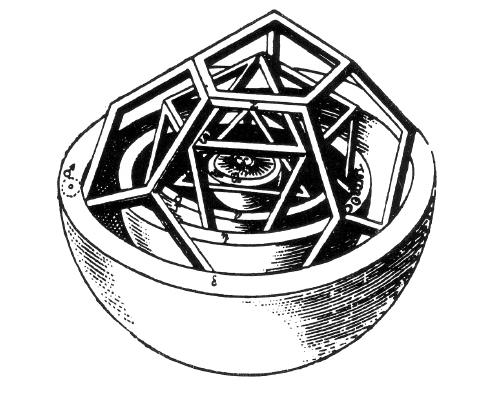
Tycho Brahe’s life as a nobleman was cut short by his untimely death in 1601, though he left a wonderful legacy of most accurate astronomical observations, resulting from 38 years of ingenious work. Kepler on the other hand, was born near Stuttgart in 1571, in post-Reformation Lutheran Germany, was deeply religious and inspired to become a Lutheran Minister, studying theology at the University of Tübingen. At University he was influenced by Copernican Astronomy, but his theological studies were paused when he became a mathematics teacher at Graz in what is now Austria. Kepler first caught the public eye upon publishing Mysterium Cosmographicum in 1596, at only 25 years old. The book explained the arrangement of the solar system planets in terms of the five Platonic solids, in a nested geometrical framework; [Figure 1].

Kepler viewed the planetary order along the lines of the “Music of the Sphere’s,” unifying the basis for the orbits of the outer and inner planets. We see this in a geometric harmony of the solar system, with the orbits of the gas giants; Jupiter, Saturn & Uranus. Figure 2 below depicts the outer, mean and inner orbits of Uranus Saturn and Jupiter using an equilateral triangle and an octagram. This is also a way of showing the structure of the musical Octave, with an eight-pointed star that halves or doubles the wavelengths or frequencies of the musical scale, with an equilateral triangle inscribed inside a circle, with 1/2 the diameter of its outer circle, in Fig. 2.
Figure 2. Geometric orbits of Uranus, Saturn and Jupiter. 2
The geometry of this diagram not only depicts the musical order of these outer solar system planets, but since Jupiter and Saturn’s orbits are in the proportion of 6:11 to 99.99% accuracy, this is the octave or double of the 3:11 Moon to Earth ratio, to 99.9% accuracy, revealing a geometric harmony and mirror symmetry between the outer and inner planets. This 3:11 earth-moon
proportion is also shared by two of our planetary neighbors, Mars and Venus, to 99.9% accuracy.
Upon closer inspection 3:11 is 27.3%, and the Moon orbits the earth every 27.3 days, in one of its
lunar cycles showing the harmonious pairing of the Earth and Moon. 3
It is this type of insight that Kepler’s Mysterium Cosmographicum afforded us, in how the heavens were Intelligently Designed with a geometrical and musical harmony in mind, according to the mathematics of the Pi, Phi and Lucas ratios. Kepler’s genius was proven in his Laws of Planetary Motion, and upheld in further scientific advances that followed. Kepler’s insight and recognition eventually brought him to the attention and economic sponsorship of Tycho Brahe, whose untimely death in 1601 was a blessing in disguise for Kepler, as this led him to a prestigious position as Imperial Mathematician in Prague, which opened access for him to Brahe’s research data.

His efforts were finally rewarded with the discovery of the first two laws of planetary motion that now bear his name. He discovered the third law several years after proposing the initial laws as he continued working on musical harmony applied to the motion of planets. Kepler’s brilliant blend of a highly creative mind with incisive and imaginative geometrical insights, worked together with his ability as a master mathematical theoretician, to produce these landmark innovations in the history of scientific astronomy.
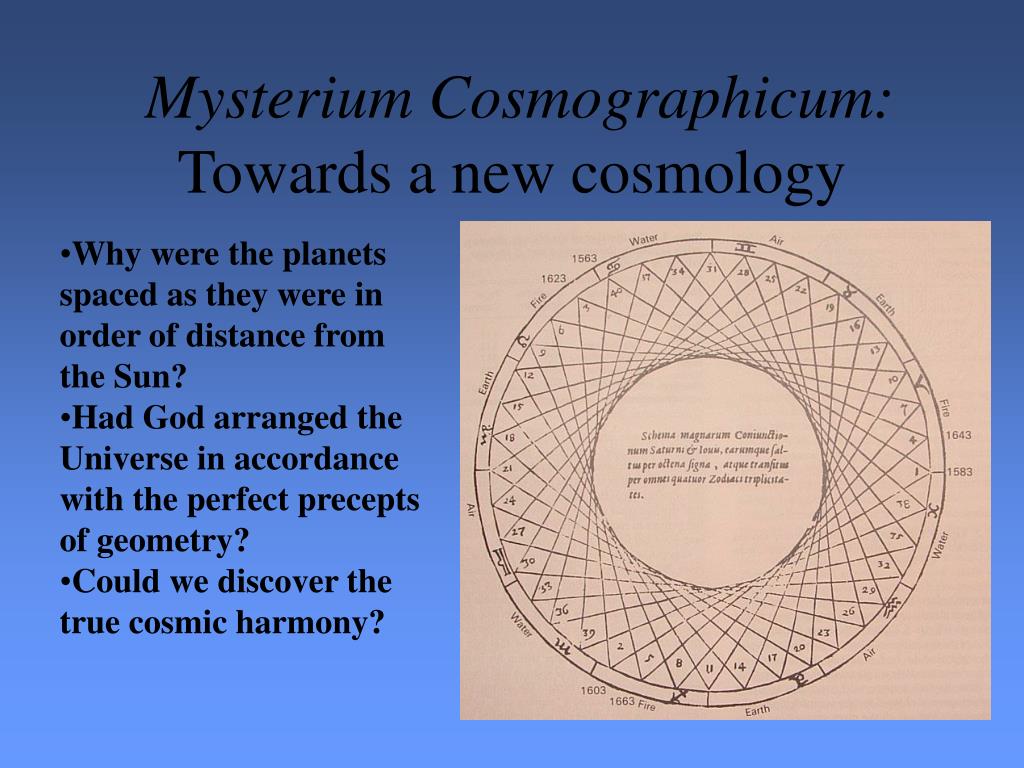
We have previously covered his observations regarding the Jupiter-Saturn Conjunction series, and their historical and spiritual impact on the birth of Christ in previous blogs relating to the Celestial Prelude, noted below for historical reference. For these and other reasons Kepler has always been one of my favorites in the field of scientific astronomy, and in this study, we take a closer look at Kepler’s work on the supernova that bears his name, and its potential links to the Coma Supernova and the Planisphere Axis. In 1573, Tycho Brahe wrote:
“Last year [1572], in the month of November, on the 11th day of the month, in the evening, after sunset, when I was contemplating the stars in a clear sky, I noticed that a new and unusual star, surpassing the other stars in brilliancy, was shining almost directly above my head; and since I had, from boyhood, known all the stars of the heavens perfectly, it was quite evident to me that there had never been any star in that place of the sky, even the smallest, to say nothing of a star so conspicuous and bright as this.”4 This supernova designated SN 1572 was seen by Brahe in Cassiopeia, but no further supernovae had since been observed with certainty in the Milky Way, until Kepler’s Nova detailed below. Bullinger tells us Brahe discovered this supernova appearing under the arm of the enthroned woman, as this “new star shone more brightly than Venus.” The beta star of the decan bears the Hebrew name Caph, meaning the branch, relating to the branch of victory she holds above her head. Cassiopeia is seated upon the Arctic circle, close by the side of Cepheus the crowned king. This the Bride, the Lamb’s wife, the heavenly city-the New Jerusalem, the partakers of the heavenly calling; [Isa. 62:3-5]. 5
This sight was so shocking to Brahe because it went against the widely accepted understanding that the universe was fixed and immutable. A few decades later, in 1604, Kepler made a similar observation that scientists and stellar observers are still puzzling over. The German mathematician and astronomer, who famously laid out the 3 laws of planetary motion, spotted a light brighter than any other star in the sky, so bright as to be visible during the day for nearly a year. He spent the next few months observing the unknown object, and wrote a book about his observations called “Stella Nova.” The Figure 3 graphic below is from Stella Nova, documenting the triangular form of Jupiter-Saturn Unions from 1583-1743.
Figure 3. The Jupiter-Saturn Great Conjunction triangle from Kepler in his De Stella Nova: 6
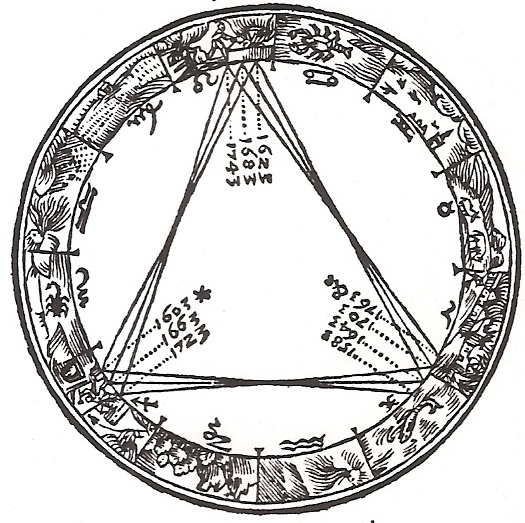
Kepler mapped, the progress of the grand conjunctions of Jupiter-Saturn through the zodiac describing a series of equilateral triangles. Every 60 years a triangle of conjunctions is completed, as the conjunction series returned to start again, shifting however nine degrees anticlockwise in respect to its predecessors, thus generating a cycle of 800 years. Figure 3 also documents [with an asterisk] inside the triangles, the union of Jupiter and Saturn in 1603 in Sagittarius to the lower left. This planetary union in the Jupiter-Saturn series predated the 1604 Supernova at Ophiuchus’ Heel, by only a few months. In the early fall of 1604, on the heels of this Jupiter-Saturn union, Mars joined Saturn in conjunction on Sept. 26th. About 2 weeks later Mars also joined Jupiter in union, about 2 degrees below it on Oct. 9th, 1604. 7 Kepler, with some contemporary astronomers of his, took specific interest in observing this union of Mars and Jupiter, which they noted relating to planetary activity surrounding the Star of Bethlehem. We have shown in previous blogs, their interest was not in vain, evident in the chart below, during the visibility of the Coma Supernova just after the Jupiter-Saturn triple conjunction of 7 BC, there was a Triangular massing of Jupiter, Saturn & Mars on Feb. 25th of 6 BC, followed by a Jupiter-Mars union in the next 8 days, along with the first of 2 Blood Moons in 6-5 BC. These served as key celestial markers that helped the Magi recognize the signs marking the birth of Christ, in 3-2 BC.
The Celestial Prelude of 7 BC to 5 BC
| Date | Conjunction of Planets | Constellation |
|---|---|---|
| May 27th, 7 BC | Jupiter-Saturn | Pisces |
| Sept. 15th, 7 BC | Jupiter, Saturn; [ring cycle], Sun & Earth aligned. | Pisces |
| Oct. 5th, 7 BC | Jupiter-Saturn | Pisces |
| Dec. 1st , 7 BC | Jupiter-Saturn | Pisces |
| Feb. 25th 6 BC | Triangular massing of Jupiter, Saturn & Mars | Pisces |
| Mar. 5th , 6 BC | Jupiter-Mars | Pisces |
| Mar. 23rd, 5 BC | Total Lunar Eclipse | Virgo |
| April 15-20, 6 BC | Lunar occultation | Series |
| Sept. 15th, 5 BC | Total Lunar Eclipse | Pisces |
Kepler was at first unable to view this supernova due to cloudy skies, but fellow astronomers Wilhelm Fabry, along with Michael Maestlin at Tubingen and Helisaeus Roeslin at Alsace were able to make their observations on October 9th, but didn’t record their findings on the supernova. 8 The supernova was first detected in Europe by delle Colombe in northern Italy on Oct. 9, 1604. 9 Kepler was only able to begin observations on 17 October while working at the imperial court in Prague. 10 In Fig. 4 below, we find a graphic of the Jupiter-Saturn & Mars union, framing Kepler’s Nova on Oct. 17th, 1604. The supernova was subsequently named after him, despite the fact that he was not its first observer, as he tracked the object for over a year. The sitings are detailed in his book De Stella nova in pede Serpentarii,(“On the New Star in Ophiuchus’s foot” Prague 1606).
Figure 4. Jupiter-Saturn & Mars conjunction, framing Kepler’s Nova on Oct. 17th, 1604. 11

Below in Fig. 5, we see the man Ophiuchus-wrestling the serpent for the Crown of Dominion, with Sagittarius, the adjacent sign-hosting the 1603 Jupiter-Saturn union, as the victorious rider whose arrows are trained on the heart of the Scorpion, [Ps. 45:5] tells a related part of the Genesis 3:15 narrative enacted by Ophiuchus, who crushes the head and heart of the serpent-scorpion underfoot in a fatal blow, while enduring the Scorpion’s sting of physical death, in sacrifice for all mankind. In the Fall of the next year 1604, due to the slow-moving outer planets, Jupiter and Saturn were still found in a similar position not far apart. This was the setting for the 1603 union of Jupiter-Saturn described above in Fig. 3, which can be seen as a Prelude to a Jupiter-Mercury union on 12-23-1603, preceded by fleet Mercury meeting Saturn on 12-22-1603, the previous day.
These two Mercury conjunctions on consecutive days culminated in a triple union of Jupiter-Saturn-Mercury on Christmas day 12-25-1603, forming a notable planetary triangle in the sky. 12 Even as the Magi were led to Jerusalem near Christmas of 3 BC, and subsequently to Bethlehem, in the Celestial Prelude of the Jupiter-Saturn triple union of 7 BC, setting the pattern for the 3-2 BC Triple union of Jupiter-Regulus, so Kepler’s Nova reminded him of the Bethlehem Star near the Jupiter-Saturn conjunction in Sagittarius of 1603, followed by the Triangular massing of Jupiter, Saturn & Mars on Feb. 25th of 6 BC, preceding a Jupiter-Mars union in the next 8 days. With the added similarities of planetary conjunctions including Mars, and the Mercury unions with Jupiter-Saturn leading to a triangular massing of planets on Christmas, we find added planetary kinship with the May 19th, 3 BC Mercury-Saturn union in Taurus as an opening sign leading to the actual parade of signs marking the birth of Christ in 3-2 BC.
Figure 5. Ophiuchus viewed between and above Scorpio and Sagittarius.
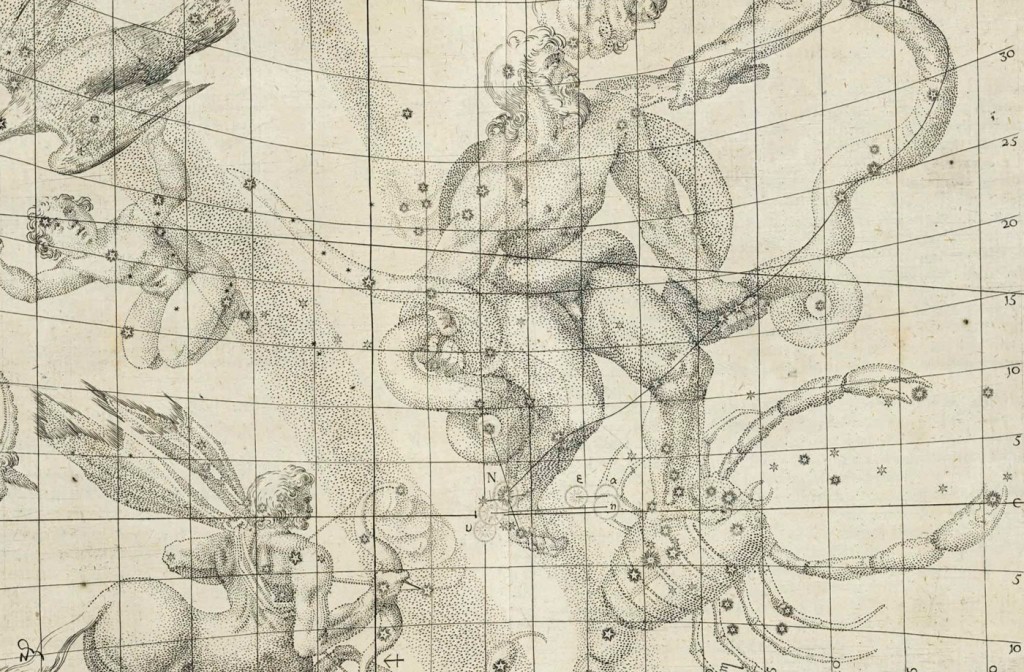
As we found in Figure 4 above, when combined with the information in Figure 3, the three planets Jupiter-Saturn–Mars are located at the vertices of the Trigon marking Jupiter-Saturn unions, linking the planetary conjunction series with Kepler’s Nova. According to William Eamon; “Kepler identified the supernova with a star that appeared in a conjunction of Jupiter and Saturn during the years 7-5 B.C.” 13 Since the supernova of 1604 appeared in a similar conjunction of Jupiter-Saturn later in the series, he reasoned it had a shared kinship with the Star of Bethlehem that showed the Magi the way to Jesus.
Below, Kepler’s drawing of the location of a new star he spotted, as it appeared on 10/9/1604. It is marked with a capital “N” located 4 grid squares up and 4 over from the left. [PUBLIC DOMAIN]
The New Star in Ophiuchus’s foot

In this enlarged graphic of this section of the sky between Sagittarius and Scorpius, where Kepler’s Nova exploded on the scene at Ophiuchus’ heel, this is truly a critical juncture or crossroads in the heavens, if you will. This is where the ecliptic, which houses the 12 signs of the Mazzaroth, [Ps. 19:4-6] crosses the Galactic equator! It is highly fascinating to me that Kepler’s Nova exploded so close to the star Saiph; which means the wounded one, as if to specifically mark it. The Planisphere axis intersects the star Saiph, in the LXX Greek meaning “bruised,” in Ophiuchus‘ heel, 14 This is the same Greek word found in Gen. 3:15 for “bruised,” while Ophiuchus’ other leg is poised over the head of the Scorpion, striking his fatal blow as he crushes the enemy. Kepler’s Supernova marked the celestial inception point of this Planisphere Axis of the Heavens, in kindred harmony with the Jupiter-Saturn conjunction cycle, which over 1600 years previous had qued the Magi to begin their trek to Jerusalem and the birth of Christ.
This is where our interest as students of Biblical Astronomy brings an added focus to the picture, with what we have already documented in previous blogs concerning the Gen. 3:15 Planisphere Axis. This Planisphere Axis intersects a series of Stars, Star pictures and decans, telling a very specific story that not only spans the Ecliptic and the Galactic Equator with the Celestial Gospel but also the Scriptures, regarding the Promised Seed Jesus Christ.
Figure 6. The Ecliptic in relation to the Galactic Equator.

It is very interesting to me that Kepler’s Supernova has not gotten more historical attention than it has, but I’m not surprised that this is the case. When we consider the location of Kepler’s Supernova in close proximity to the Star Saiph in Ophiuchus’ Foot, being stung by the Scorpion, we are witnessing the first of multiple heel alignments on the Planisphere Axis relating different aspects of the victory of the Promised Seed over the Serpent, as promised in Genesis 3:15. Figure 6 above shows the Galactic Axis in harmony with the Axis of the Planisphere extending through Ophiuchus’ Heel between Sagittarius and Scorpius, on one end with Orion at the other end of the Galactic Plane, depicting the relationship of the Milky Way Galaxy.
Gen. 3:15 And I will put enmity between thee and the woman, and between thy seed and her seed; it shall bruise thy head, and thou shalt bruise his heel.
Figure 7. Gen. 3:15 Planisphere Axis.
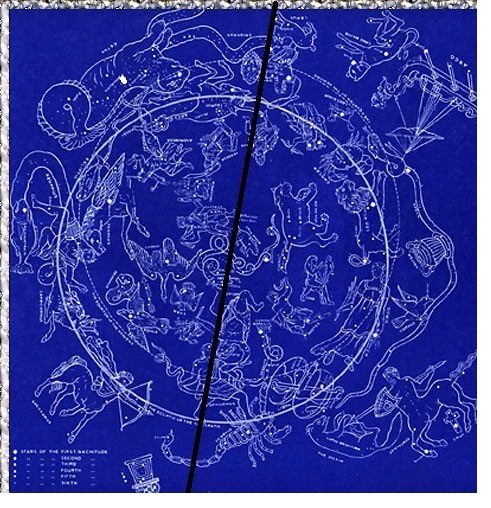
If we now look at the other end of the Gen. 3:15 Planisphere Axis, we find amazingly that it intersects Orion, specifically at the star in Orion’s foot named Rigel, 16 meaning “the foot that crushes,” which is fitting since it’s pictured crushing the enemy. The main star in Orion’s other leg incredibly is “Saiph” the same word for “bruised“ we saw in Ophiuchus found in Gen. 3:15! Not only do we find both ends of this amazing Planisphere Axis agreeing with the same star name linked to Gen. 3:15, but before the axis reaches Orion’s foot, it intersects the bright star in Orion’s shoulder called Bellatrix, meaning “swiftly destroying,” referring to the swift destruction of the enemy resulting from the perfect sacrifice or “bruising” of the Lord Jesus Christ.
This reference to the spiritual battle between light and darkness, between the serpent and its seed, versus the Woman and her seed, emblazoned in the Star Gospel as God published the serpent’s interminable attempts on the life of the woman’s seed; Jesus Christ who bruises the serpent’s head, indicating the fatal blow that Christ inflicts on the enemy, as opposed to the scorpion stinging Christ’s heel, exhibiting the temporary wound [Saiph] of Christ’s sacrifice, as short-term sufferings that freed all mankind from the serpent’s curse, for eternity!
The “Genesis 3:15 axis” extends through the North pole intersecting a number of constellations and decans relating aspects of the Genesis 3:15, theme from various teaching perspectives. Starting at the bottom of this planisphere axis, we find the Scorpion constellation–Scorpius, whose prominent tail stinger is positioned just under the heel of Ophiuchus the Serpent-bearer constellation, who is also wrestling the serpent as the Scorpion stings his heel. Kepler’s Nova marked the star Saiph at the opening of this Galactic Axis where it crosses the paths of the Sun and Planets through the 12 signs of the Mazzaroth, calling focused vigilance
to this axis, and its alignment of Heels across the heavens between two Stars named “Saiph,” at each end of the Genesis 3:15 Axis. This also establishes the message of Scripture in the first prophecy of the Promised Seed in Genesis, in its three Scriptural elements of the star picture in Fig. 5. The Hebrew word for Scorpion is Akrab, meaning war or conflict; [Ps. 91:13] with the man. 15
Figure 8. Orion, Lepus and Eridanus. 16

As Fig.6 depicts the relation between the Ecliptic and Galactic planes, we can see how the Milky Way crosses the ecliptic constellations between the Scorpion and Sagittarius the Archer to the South, and between the Bull-Taurus and Gemini to the North. A similar view of this Galactic Cross below, depicts the Sagittarius–Gemini Axis intersecting the Virgo-Pisces Axis, that we have discussed previously in a website study pertaining to the Dendera Zodiac with its Axis E. An added detail of the Dendera Zodiac, shows how Axis E points to the sightline for the Galactic Center, located at the tip of the Archer’s arrow, at the Scorpion’s heart.
In the constellation of the Archer–Sagittarius, the star gamma, shown by the Greek letter akin to a “y,” marks the tip of the arrow sited on the Scorpion. The galactic center (GC) is just above his line of sight. A closer look at this part of the sky reveals the Archer’s final target as the star Antares in the heart of the Scorpion, but due to its near proximity to the Galactic Center; GC, the Archer’s aim appears to point beyond the GC towards Antares. The graphic is described by Graham Hancock as follows;
“The image above shows the celestial setting on 12-17-2012, the Sun has shifted out of the constellation of Scorpio, seen to the right, and is about to enter the constellation of Sagittarius. The yellow horizontal line represents the Plane of the Ecliptic. The cyan colored diagonal line represents the plane of the Milky Way Galaxy. The galactic center can be seen at the intersection of the galactic plane and the bright green vertical line. The heavy white line represents the Winter Solstice. On this day the Sun is closer to the Galactic center than at any other time in its yearly journey through the constellations of the zodiac and is poised precisely at the tip of the Archers arrow. Four days later the Sun crosses the galactic plane on the day of the Winter Solstice.” 17
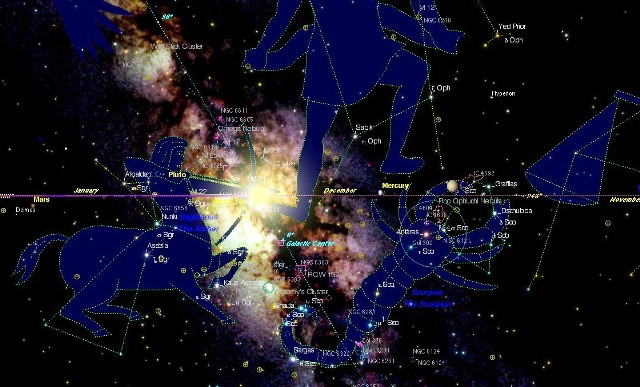
Hancock adds; “This unique perspective is due to the fact that the Earth, the Sun and the Galactic Center are arranged in a quite accurate alignment at an auspicious moment, the moment of Winter Solstice when the Sun begins its return journey to the Northern Hemisphere. 18 As the Sun on the ecliptic moving in its solar cycles, represents Son of God moving ever closer towards his return to gather his saints.
What is striking about this graphic is this alignment of the Earth, and Sun at the Galactic Center during the Winter Solstice, seems to mirror the position of Kepler’s Nova in marking Ophiuchus’ Heel at this key celestial juncture-the heavenly crossroads of the ecliptic and the Galactic Equator! This celestial convergence of signs including a supernova, a Solar conjunction and alignment at the Winter Solstice, that also coincides with the Magi’s arrival in Jerusalem near Christmas, is certainly worthy of our attention.

It seems clear, as the point of the solstice is nearing alignment with the Galactic Center, illustrated by the point of the Archer’s arrow reaching the center target of the Milky Way, is another indicator that we are in the end times, near the Lord’s Return.
Bullinger informs us that “the Arabic name for the sign Sagittarius is Al Kaus, the arrow.”6 This is the king riding in the judgment of Numbers 24:8 who “eats up the nations of his enemies, and shall break their bones, and pierce them through with his arrows.” We find more details of the Lord’s return in Habakkuk 3.
Habakkuk 3:3-13
3 God came from Teman, and the Holy One from mount Paran. Selah His glory covered the heavens, and the earth was full of his praise. 4 And his brightness was as the light; he had horns coming out of his hand: and there was the hiding of his power. 5 Before him went the pestilence, and burning coals went forth at his feet. 6 He stood, and measured the earth: he beheld, and drove asunder the nations; and the everlasting mountains were scattered, the perpetual hills did bow: his ways are everlasting. 7 I saw the tents of Cushan in affliction: and the curtains of the land of Midian did tremble. 8 Was the LORD displeased against the rivers? Was thine anger against the rivers? Was thy wrath against the sea, that thou didst ride upon thine horses and thy chariots of salvation? 9 Thy bow was made quite naked, according to the oaths of the tribes, even thy word. Selah Thou didst cleave the earth with rivers. 10 The mountains saw thee, and they trembled: the overflowing of the water passed by: the deep uttered his voice, and lifted up his hands on high. 11 The sun and moon stood still in their habitation: at the light of thine arrows they went, and at the shining of thy glittering spear. 12 Thou didst march through the land in indignation, thou didst thresh the heathen in anger. 13 Thou wentest forth for the salvation of thy people, even for salvation with thine anointed; thou wounded the head out of the house of the wicked, by discovering the foundation unto the neck.
Here in verses 8-9 we see the Lord fulfilling the oaths of the deliverance of the tribes of Israel, as he bends his mighty Bow in judgment. As he brightly brandishes the weapons of his warfare, his arrows and spear, the heathen fall before him. He wounds the head or leaders of the wicked unto their foundations. None can stand before the wrath of the lord but the righteous, in his coming judgment. This is the mighty Sagittarius riding into Christ’s ultimate victory with his ascended Saints, over the wicked powers of darkness. [Hab. 3:13]
With each passing day, we draw nearer to the undeniable victory of the Lord’s Return! As we witness the signs of the Lord’s rapid Return, we should be rejoicing in this great Hope the Almighty has provided for us, in our daily journey on the paths of Light set before us. In our daily walk, we can also recall the words of Johannes Kepler, who admonished us, above all else, that we are mindful to pursue God’s Glory, not our own.

God Bless!
Agape’
Rene’

Footnotes
1. [tallbloke.wordpress.com] Figure 1 picture credit.
2. “A little book of Coincidence,” p. 48, John Martineau, Wooden Books 2001
3. IBID p. 30
4. “Kepler and the Star of Bethlehem.” W. Burke-Gaffney, Journal of the Royal Astronomical Society of Canada
5. “Witness of the Stars,” ppg. 108-109 E.W. Bullinger
6. Figure 3, picture credit from De Stella Nova. Johannes Kepler
7. “Kepler and the Star of Bethlehem.” W. Burke-Gaffney, Journal of the Royal Astronomical Society of Canada
8. IBID
9. IBID
10. “Bill Blair’s Kepler’s Supernova Remnant Page”.
11. Figure 4 picture credit; [Grailgate.com]
12. “Kepler and the Star of Bethlehem.” W. Burke-Gaffney, Journal of the Royal Astronomical Society of Canada
13. “Kepler and the Star of Bethlehem.” Wm. Eamon, [https://williameamon.com/?p=949]
14. “Witness of the Stars,” E.W. Bullinger
15. “Witness of the Stars,” p. 58 E.W. Bullinger
16. Witness of the Stars, picture credit for Figure 9. E.W. Bullinger,
17. Graham Hancock
19. IBID